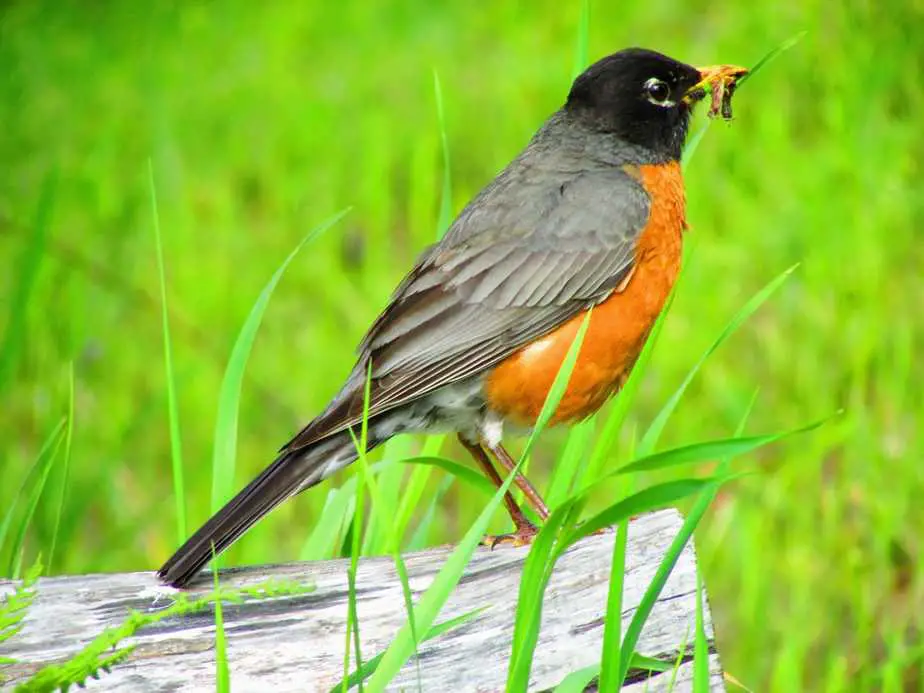If you’re planning to head to Kentucky for your next birding experience, you’ll want to have this handy guide to help you identify the most common backyard birds of Kentucky! In this article, we’ll be providing you with identification tips, fun facts, and bird calling videos!
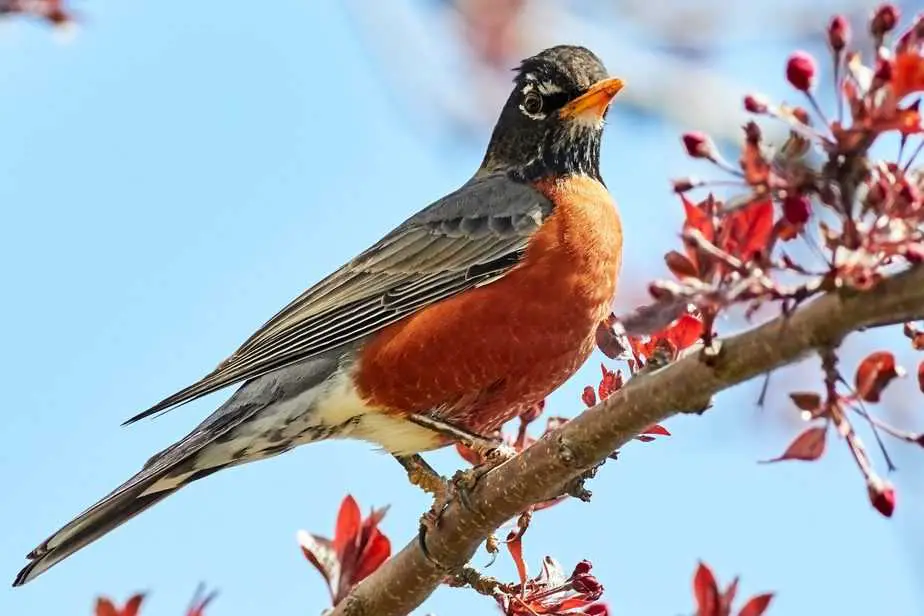
Without further ado, let’s jump right in!
Table of Contents
1. American Robins
The first bird in our guide, the American Robin is a backyard staple in Kentucky! These songbirds can be seen carrying a beautiful tune and hopping around the yards and woodlands of Kentucky, and are fairly large in size. They can be found all across the state, and during the winter, will be spotted in flocks eating berries.
The American Robin isn’t the shyest of backyard birds, and won’t be hard to get a good look at or photograph of. These birds like to puff their chests out, hold their beaks high, and stand tall – even when people are present! Robins are known for their gorgeous aqua blue eggs, so if a nest of bright blue happens to catch your eye, you can be sure a Robin is nearby!
Identifying American Robins
Because American Robins are generally seen all throughout the United States, it shouldn’t be too difficult to identify them. Here are some pointers for proper identification:
- American Robins are large songbirds. They’re a bit smaller than a Crow, and when other songbirds are present, they tower over them with their lean builds.
- A Robin’s coloring is darker on top and bright on the underbelly. Robins are gray-black birds with darker heads (lighter on the females), wings, backs, and tails, with reddish-orange chests and bellies. Underneath their tails is a patch of bright white for in-flight identification. They generally have orange or yellow beaks.
- Robins have round bodies but stand tall and lean. When a Robin is relaxed on a branch, you’ll notice their round heads and bodies, and long skinny legs. When they’re hopping along the ground, a Robin will stand tall, lean, and elongated.
Click the video below to listen to the call of American Robins:
2. Northern Cardinals: The State Bird of Kentucky
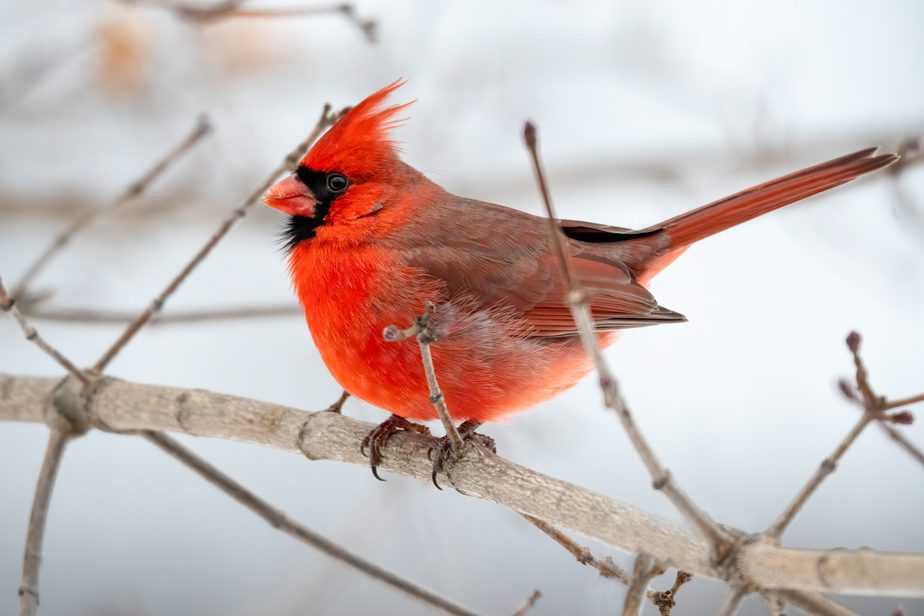
Adorned with bright red feathers and a black mask on its face, the Northern Cardinal is Kentucky’s State Bird… well, the male Northern Cardinal, that is!
Female Cardinals are rather dull in coloration and have very few orangy-red feathers compared to their male counterparts. Female Cardinals look similar in feather pattern and body shape to males, but are light brown in color, with faint orangy-red coloration at the tips of the feathers on their wings, tail, and head.
Cardinals are often found hopping around the backyards of Kentucky or bouncing from branch to branch in shrubby wooded areas on the outskirts of towns. They’re often seen in pairs, low near the ground, and may even be seen with their mates (be on the lookout for one red and one brown Cardinal!).
Identifying Northern Cardinals
Cardinals are hard to miss, but there are a few characteristics that will help you quickly identify them:
- Their coloring is unmistakable among the backyard birds of Kentucky. Male Cardinals are a vibrant red all over, with dull black on the wings, and deep black coloring on their faces. Females are also recognizable, with their spurts of orangey-red at the tips of their feathers.
- A Cardinal’s beaks are thick and short, and orangey-red in color. Compared to many other songbirds, a Cardinal’s face is unique in that it has a stubby beak, rather than a long, slender beak for digging worms out of the ground.
- Cardinals are fairly large songbirds, though smaller than a Robin. They also have prominent chests and rounder bodies, with short feet and a long tail.
Click the video below to hear the calls of Northern Cardinals:
3. Carolina Chickadees
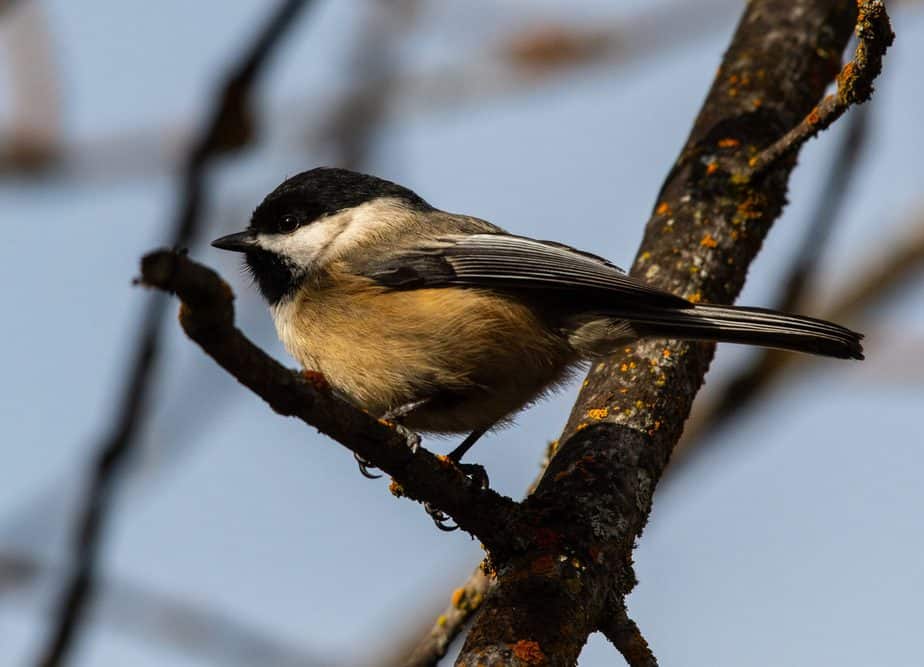
Petite and round, the Carolina Chickadee is as small as a House Sparrow, and a little larger than a house finch, making them on the smaller end of the birding spectrum. This is a flocking species, and will generally be seen around many other small species of bird. You’ll see them hopping around yards, in parks, or in shrubby, foresty areas in the branches of bushes and trees.
Identifying Carolina Chickadees
If you’re able to spot these tiny Kentucky birds, here’s how you can identify them:
- A Carolina Chickadee consists of neutral coloring. Their heads and faces are black, with two white stripes lining the sides of the face, and back of the neck. Their chests and underbellies are generally pale tan in color; and their wings, backs, and tails are a light gray with gray tone variations.
- These birds are tiny in stature and have a distinct rounded body. Its thick, short neck and larger head give this bird a stumpy appearance.
- Carolina Chickadees have longer tails that are narrow in width. Their beaks are on the shorter side, and triangular, with a bit of thickness to it.
Click the video below to hear the call of Carolina Chickadees:
4. American Crows
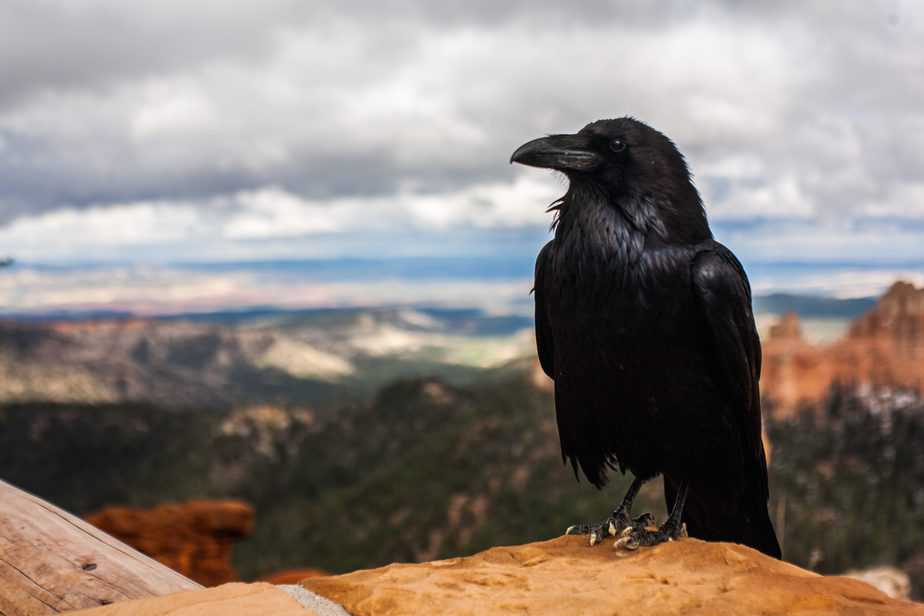
Known for their all-black, rigid appearance, the American Crow is often utilized in horror movies and stories to create a sense of eeriness. Unbeknownst to some, Crows are actually very social and will come together in large flocks, vocalizing and socializing together. If they feel threatened by larger birds, such as hawks, they’ll drive them away.
American Crows are also fairly intelligent, and when they set their minds to something (usually pertaining to finding food), they’ll get it done. For example, Crows will pick at trashcans in order to get at the food inside or will watch a scarecrow to see when the “person” moves away from the corn so that they can swoop in and eat. Especially intelligent Crows may even learn that a scarecrow isn’t a person at all, and will take advantage of a farmer’s crops.
Crows can be seen in open fields, near backyards (though they’re not as common in suburban yards), and other large fields in populated areas. They can also be seen at the edge of woodlands and forests.
Identifying American Crows
These foreboding birds are easy to spot among the backyard birds of Kentucky due to their size and coloration. Here’s how you can identify them:
- American Crows are all-black in color… even their beaks, legs, and feet are black. Their feathers are also black, with a glossy sheen that can boast faint deep greens and purples in the sun.
- These birds are considerable in size and are bigger than most backyard birds. Crows are a little over a foot in length, from head to tail, on average.
- Their beaks are long and thick, and Crows have larger feet, as well.
Click the video below to hear the call of American Crows:
5. European Starling
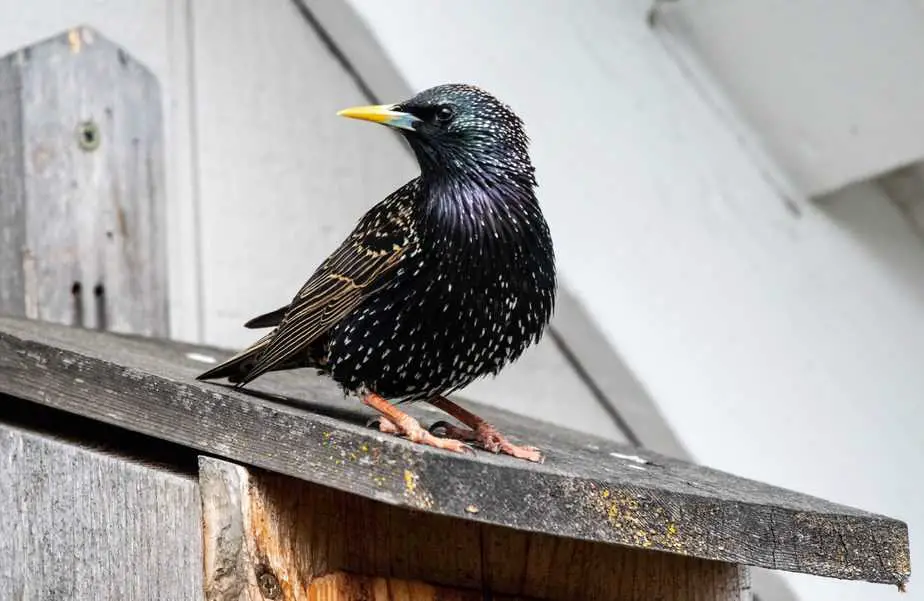
These boisterous birds aren’t afraid to make their presence known. Often seen in large flocks of birds, including Blackbirds and Grackles, the European Starling is a social and vocal bird. You’ll find these birds in open fields, searching the dirt for tasty bugs, or sitting in high trees or on electrical wires, making their distinct calls.
Identifying European Starlings
The unique coloration and build of European Starlings make these birds quite recognizable… here’s how to do it:
- A European Starling looks all-black from afar but boasts deep purple and green hues during the warmer months from their heads to the tips of their tails. During the winter, a European Starling’s new set of feathers are deep brown with stunning white spots from head to tail.
- Their beaks and feet are recognizable compared to other backyard birds of Kentucky. A European Starling’s beak is a bright yellow, long in length, and skinny, and pointed. Their feet are orangey-yellow and long.
- European Starlings are medium-sized birds… about the size of a Robin (or a tad smaller).
Click the video below to hear the call of European Starlings:
6. American Goldfinch
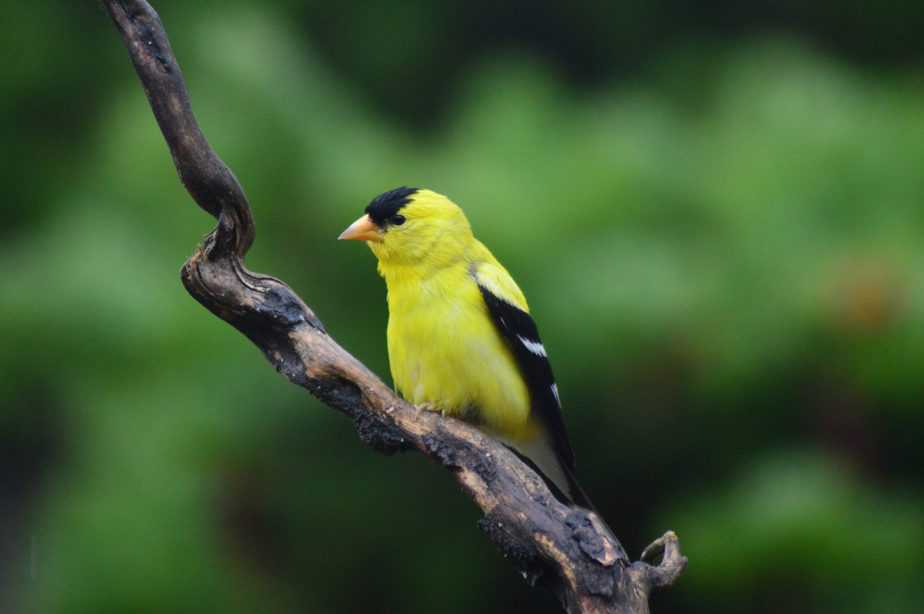
These dainty birds are vocal and vibrant, boasting brilliant colors on their tiny bodies. American Goldfinches are a bouncy, athletic backyard bird of Kentucky, and are often seen hanging from birdfeeders or nibbling on wild seeds in weedy, open fields. They can be found, usually in groups, flying in sporadic patterns, and even calling as they fly.
Identifying American Goldfinches
If you’re on the hunt for American Goldfinches, here are some foolproof ways to identify them:
- During the summer, male American Goldfinches are gold (hence their name), or bright yellow, in color. Their wings are deep black, with white patterning, and they have black on the tops of their heads near the beak. Female Goldfinches are also yellow in coloring during the warmer months, though their coloring is much duller (with a brownish hue) than their male counterparts. A Female’s wings are also black, but overall dull.
- These birds are small in size, smaller than a Robin, and about the size of a Sparrow.
- Their beaks are either dull or yellow in color, with medium thickness, and on the shorter side.
Click the video below to hear the call of American Goldfinches:
7. Carolina Wrens
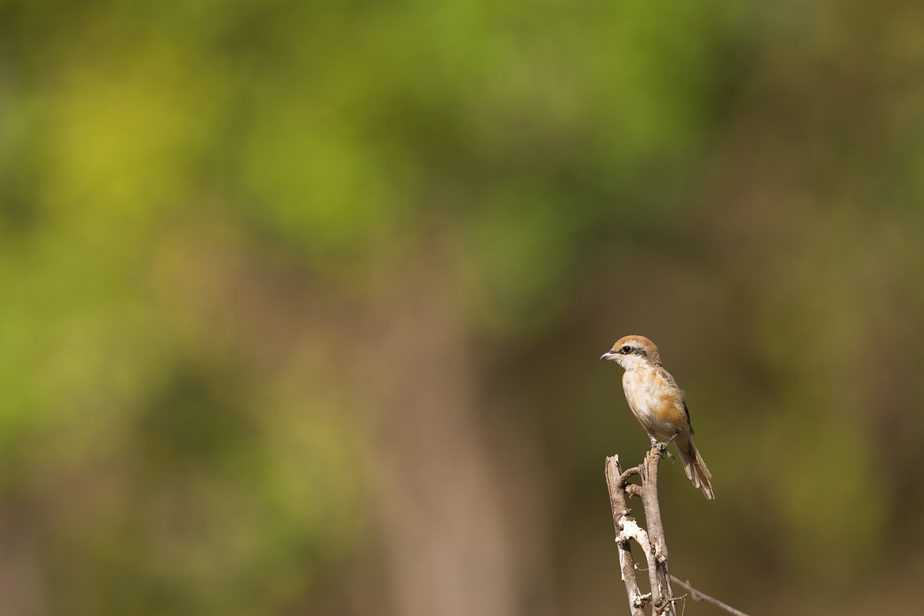
The final tiny backyard birds of Kentucky, the Carolina Wren is smaller than a Sparrow. Though small, these birds are mighty and will defend their nests and territories by singing constantly to make their presence known. If a larger bird gets too close, they’ll even attack and shoo them away!
You’ll find these vocal little birds all over Kentucky, in backyards, in cultivated areas, and on the edges of woodlands hopping around trees and bushes.
Identifying Carolina Wrens
If you can spot these tiny birds, Carolina Wrens can easily be identified by a few key characteristics:
- Male and female Carolina Wrens are reddish-brown in color, on their backs, wings, and tail. Their underbellies are a pale orange tone, and underneath their chins and throats is white coloration. Above each eye is a single horizontal white stripe heading down the back of the head.
- A Carolina Wren’s beak is dark gray or black in color. It’s on the skinnier side and extends longer out from the face.
- These birds are very small in size and are a tad smaller than a Sparrow. Their tails are narrow and they have shorter, pointed wings.
Click the video below to hear the call of Carolina Wrens:
8. Blue Jays
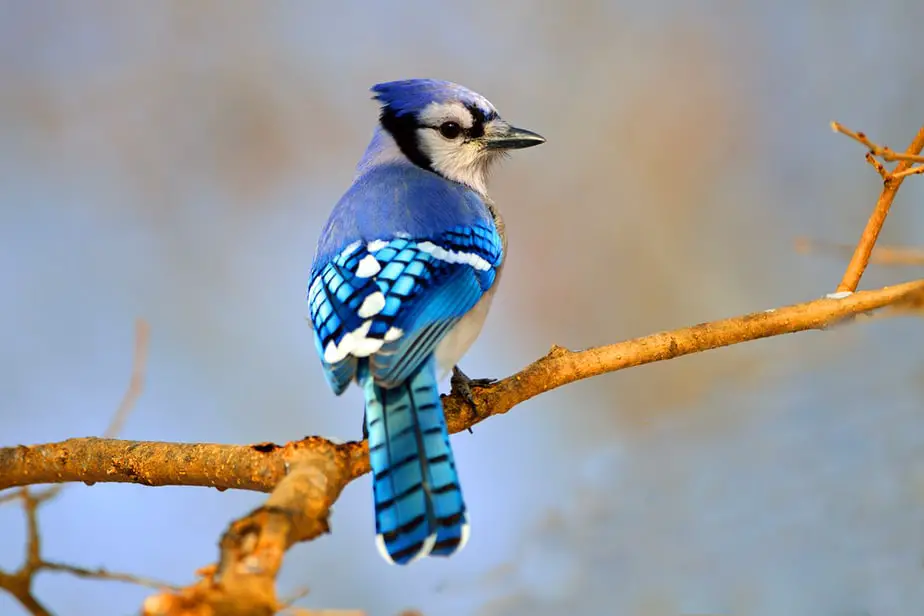
The Blue Jay has been seen all throughout the United States and is commonly found in Kentucky. It’s also one of the many common bird species in Texas. It’s characterized by its vibrant blue coloring and unique appearance. You’ll find these birds on the outer edges of woodland areas or near trees that drop their favorite wild nuts, such as Oak Trees.
Identifying Blue Jays
Thanks to their blue hues, identifying the aptly-named Blue Jay isn’t a difficult feat. Here’s how:
- Their bright, blue coloration is the most identifiable factor of a Blue Jay. Blue Jays are blue all over, with unique patterning on the wings and tail. The patterning features variants of blue hues, white, and black, and the feather pattern has a “scaly” appearance.
- Blue Jays are medium-sized backyard birds of Kentucky, about the size of a Robin.
- Blue Jays feature a mask-like pattern on their faces and a cone-shaped puff of feathers at the top of their heads.
Click the video below to hear the call of Blue Jays:
How to Enhance Your Bird Watching Experience
If you’re new to birding and aren’t sure how to make the experience as best as possible, here are a few pointers to increase your chances of seeing the common backyard birds of Kentucky:
1. Hang Around Bird Feeders & Bird Baths
If you’re looking for a simple way to catch a glimpse of common bird species, find a bird feeder and watch it closely. Bird feeders are a great way to see which birds are most abundant in an area. Of course, you won’t be able to get photos of the bird(s) in their natural habitat, but watching a backyard bird feeder is an excellent way for identification.
During the warmer months, you can also keep a close eye on a bird bath. Small birds will flock to bird baths to drink and cool themselves in the water.
2. Make Sure You’re in the Right Habitat
Most backyard birds of Kentucky can be found in populated areas, such as gardens, yards, on electrical wires, and even in the parking lots of stores. If you’re searching for a particular species, be sure that you know where they’re most commonly seen in the wild. For example, you’ll likely find Cardinals on the outskirts of woody areas, and Crows in open fields.
3. Be Patient
You won’t get that sought-after photograph of wildlife if you’re angsty. Birds are skittish creatures and will hop along the ground, interact with other birds, and dig for an insect or two, or peck at wild seeds. Patience is essential for getting a good look and capturing a quality photo of birds.
4. Try Throwing Seeds Out
If you’re having trouble getting a good look at the birds, you can resort to throwing seeds on the ground in a quiet area to create a feeding station, backing away to a reasonable distance, and waiting for the birds to flock to the food. This is a great way to get a close look at the native species, but again, won’t give you a natural photograph if that’s your goal.
5. Blend into Your Environment
Camouflage is ideal for blending into your surroundings and preventing the birds from becoming aware of your presence. The more you disappear into the trees, bushes, and foliage of the habitat, the better. Try wearing browns, tans, and deep green colors for the best effect.
6. Be Quiet and Try Not to Get Overly Excited
If this is your first birding trip, you may get excited when you see the first bird on your list (and rightly so)! However, birds are flighty (literally) creatures and will flee at the slightest movement or sudden sound. It’s important that when you’re birding, you stay quiet and only whisper if you need to speak. Try finding an area where you can place a chair so that you’re not uncomfortable while waiting on the birds.
Final Thoughts
There are many species of birds that call the hills of Kentucky home, and these backyard birds of Kentucky are just the most common of them! From the minuscule Carolina Wren to the foreboding black Crow, Kentucky is home to some of the most stunning birds in the United States!
We hope our guide to the backyard birds of Kentucky has been a help in cultivating your birding experience! Happing bird watching!
